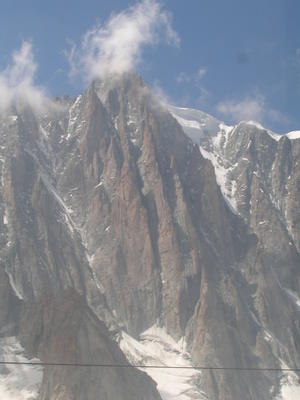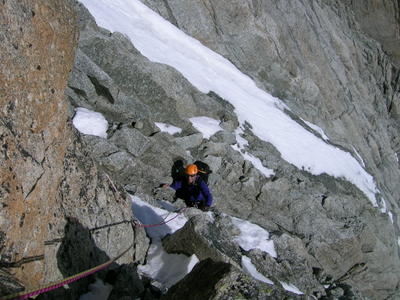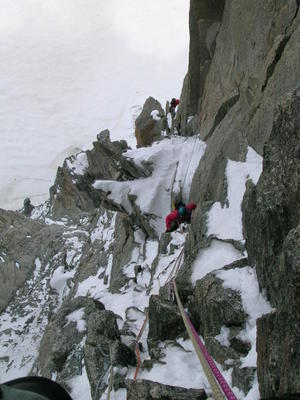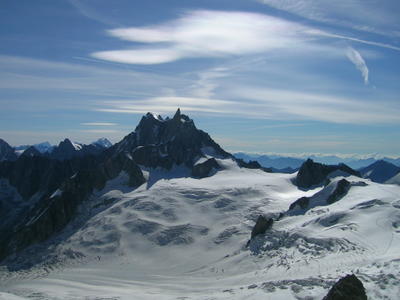Cirque of the Towers, July 2012
For photos, see my picasaweb site.
Bob Palais and I went to the Cirque of the Towers July 28-31, 2012. Like many other visitors to this area, our goals were the two 50 classic climbs, Pingora NE face and Wolf's Head E ridge. They would bring my total to 21. Bob had already done Pingora a long time ago, but didn't remember much about the route. We got organized and drove to Farson the day before, staying at Sitzman's Motel. The 9 mile approach to the Cirque from Big Sandy trailhead with camping and climbing gear was pretty taxing for us, but we got set up and were up the next morning at 5:30 ready to approach the NE face. No competitors for this route, I think its length and sustained grade keeps the crowds away (unlike Wolf's Head). Having garnered an excellent topo and route photo from the internet, we were ready for action anxious not to waste precious time on off-route diversions--the possibility of afternoon thunderstorms puts a premium on speed. Today, however, we had no such problems, and once we got fairly high on the route without any sign of incoming weather, we were able to relax a bit.
The first pitch went pretty smoothly on the lead, as I remembered some poster's comments about needing to downclimb a bit for the easiest passage on the traverse. Easy for me as the leader, having gear diagonally above, but it left Bob in an unpleasant position with the next piece far off to the left and only a little up. Better would have been to place a piece at the end of the downward bit, even though it would be below the second climber--at least it would be nearby. Bob managed by climbing an alternate lower line (harder, but better protected for the second). The next 4 pitches were long (160+ feet) and tiring. I've found it recent years that I'm much more comfortable with shorter pitches of 100 feet or so since it limits rope drag and allows for a more even expenditure of energy. I hate that frantic feeling as you get near the end of the rope, extremely tired, with a nearly empty rack, looking for the belay. The climbing suited me, though, with a lot of layback-type moves following a clear corner system. I broke the sixth pitch into two. This brought us to the crux pitch of the route, the wide section, 5.8. There is a 5.9 lieback corner alternative, but this looks rather strenuous. Since this is a short pitch, I led up on one of the 7.8mm ropes, doubled, and trailed the other to haul the packs. This seems advisable since it is hard enough scraping up the thing, why make it even harder dealing with the pack? I did lose a lot of energy on the climbing and hauling, though, and the day's work began to take its toll on me. I had some cramping in my hands towards the end of the next pitch (normally I don't have this problem, but it tends to happen when doing hand hauling--it would have been better to rig something with tiblocs to lessen the toll on the hands). There was some back and forth in postings about whether to bring a #4 Camalot for the wide pitch. As it turns out, the #3 was what I placed at the crux, though I did place the #4 higher up on the pitch. Despite its weight and awkwardness, I think it is good to bring the #4 since the alternative would have been to double up on the #3 size, so the actual weight savings would not be that great. There were plenty of places on the route to use the #4--or perhaps to get rid of it so the second has to carry it the rest of the way up the pitch!
Having completed the crux pitch, we thought we had the route in the bag, but the NE face was not going to let us off quite so easily. Altitude and a long day of strenuous climbing was taking its toll, and our progress slowed considerably. The pitch after the wide bit was a long diagonal corner system with a couple of 5.7 sections. This became something of a psychological crux for me because halfway up I became convinced I was off route as I couldn't recognize some of the features in the topo, in particular the "off route chimney." This remains a bit of a puzzle to me since I now know I was right on route and really, how can one miss seeing a chimney? Some grass in the crack and a lack of a clear destination for the pitch added to my anxiety about being on route. I down climbed a bit to seek alternatives, but Bob reassured me that I was on track, so I forged on to about 160 feet. At this point I was nearly out of gear and rope so I needed to belay, no matter what. I found a small stance but I was a little insecure about the gear placements--I had one good #1 cam and a couple of somewhat flaring placements. I added a #5 rock under the #1 cam and so I was satisfied, but the whole process took quite a lot of time. (From a gear sling with doubles to #2 plus #3, #4, I was left with nothing but 4 rocks on a biner!) As it turned out, given an opportunity to rest and chill out a bit, I recognized that the usual belay was a mere 10 feet to the right, next to a flake which is the start of the last 5.8 pitch. So when Bob came up he shifted over there. The 5.8 pitch was quite interesting, with some delicate moves as one shifts from one crack to the next.
At this point, the topo says there's an "easy chimney" followed by 5.4 to finish the route. The Deep Lake/Cirque guide calls it 5.6. It is too much of an open book to do much in the way of chimney techniques--one has to exploit face holds and jams. I got up about 15 feet, faded, and lowered off. Bob told me he's got this, it's his forte, so I was happy to trade ends. And giving a nod, up the chimney he rose! Not only that, but he pulled up my pack and anchored it above the chimney. Thus unburdened, I was able to drag myself up the thing. We both thought it was harder than the supposed crux 5.8 pitch. The time was 4:30pm (we started pitch 1 at 7:30am).
Despite our tired state, we both thought it would be cool to finish with the optional 5.6 to the NE summit. I was happy just to sit and belay to recover from the "easy chimney." Bob went partway up and I finished the crack, which turned out to be 4 inches wide. Turns out a short rap is needed to get down from the NE summit. We checked out the true summit and rapped down the South Buttress route (our plan had been to TR the K-crack but that wasn't going to happen at this point).
The next day we were recovered enough to get up fairly early and head for Wolf's Head. The approach to the ridge goes up a surprisingly easy feature known as the "grassy ledges." We saw other climbers up on the ridge and hoped that they were far enough ahead to avoid slowing us down. Soon we were on the ridge, and Bob started up the 18 inch wide "sidewalk pitch," and then we simulclimbed to the first tower. At this point we hit the climber traffic, which consisted of a party of 3 and two parties of 2 ahead of us. My first reaction was to just simulclimb through, but the route is just not set up well for passing except at belays, with its assortment of chimneys and airy foot and hand traverses. The leader in the first party of 2 made it clear he would maintain a strict queue, no matter how long it took. I declared it would take us 5 hours to do the ridge, but having concluded there was nothing I could do to speed it up, I lay down on a nice flat, sunny area to wait and nap. Luckily, the party of 3 was anxious not to hold everyone up and asked the next group to play through at the next belay. After declining the offer initially, they did go ahead, and miraculously the logjam began to move after only an hour or so.
The first pitch descended to a bouldery move to bridge over a gap, followed by a chimney that was not a chimney (because you could climb on the outside--that's my kind of chimney!). Then the "piton pitch" which follows a horizontal crack out an otherwise blank wall (here I clipped a crucial pin with just one of our two strands of rope, and Bob arranged a backrope with the other to provide an extra measure of security--we were climbing with the one 7.8mm rope doubled up). We had to wait at the belay after that. Soon sounds of thunder could be heard and dark clouds could be seen in the area. Bob was frantic to get the parties in front of us to move faster, since Wolf's Head, with its sharp ridge and pointy towers, is about the worst possible spot to be in a thunderstorm. Eventually we got going again, and were treated to two beautiful pitches--one with a crack just below a razor ridge, and one with a 3 inch ledge on a 70 degree holdless wall that enabled an easy but very insecure foot traverse (Bob did it as a hand traverse). Between these two pitches we passed the party of 3. From here we could simulclimb to the summit. The six of us reached the summit within a few minutes of each other. It turns out Bob knew two of the other climbers and had even climbed with one of them over 20 years ago in Tuolumne (they were father-son teams, the fathers having climbed the route 34 years earlier). We combined forces for the rather involved descent, which involves six rappels interspersed with sections of scrambling, down, across, and up.
Bob Palais and I went to the Cirque of the Towers July 28-31, 2012. Like many other visitors to this area, our goals were the two 50 classic climbs, Pingora NE face and Wolf's Head E ridge. They would bring my total to 21. Bob had already done Pingora a long time ago, but didn't remember much about the route. We got organized and drove to Farson the day before, staying at Sitzman's Motel. The 9 mile approach to the Cirque from Big Sandy trailhead with camping and climbing gear was pretty taxing for us, but we got set up and were up the next morning at 5:30 ready to approach the NE face. No competitors for this route, I think its length and sustained grade keeps the crowds away (unlike Wolf's Head). Having garnered an excellent topo and route photo from the internet, we were ready for action anxious not to waste precious time on off-route diversions--the possibility of afternoon thunderstorms puts a premium on speed. Today, however, we had no such problems, and once we got fairly high on the route without any sign of incoming weather, we were able to relax a bit.
The first pitch went pretty smoothly on the lead, as I remembered some poster's comments about needing to downclimb a bit for the easiest passage on the traverse. Easy for me as the leader, having gear diagonally above, but it left Bob in an unpleasant position with the next piece far off to the left and only a little up. Better would have been to place a piece at the end of the downward bit, even though it would be below the second climber--at least it would be nearby. Bob managed by climbing an alternate lower line (harder, but better protected for the second). The next 4 pitches were long (160+ feet) and tiring. I've found it recent years that I'm much more comfortable with shorter pitches of 100 feet or so since it limits rope drag and allows for a more even expenditure of energy. I hate that frantic feeling as you get near the end of the rope, extremely tired, with a nearly empty rack, looking for the belay. The climbing suited me, though, with a lot of layback-type moves following a clear corner system. I broke the sixth pitch into two. This brought us to the crux pitch of the route, the wide section, 5.8. There is a 5.9 lieback corner alternative, but this looks rather strenuous. Since this is a short pitch, I led up on one of the 7.8mm ropes, doubled, and trailed the other to haul the packs. This seems advisable since it is hard enough scraping up the thing, why make it even harder dealing with the pack? I did lose a lot of energy on the climbing and hauling, though, and the day's work began to take its toll on me. I had some cramping in my hands towards the end of the next pitch (normally I don't have this problem, but it tends to happen when doing hand hauling--it would have been better to rig something with tiblocs to lessen the toll on the hands). There was some back and forth in postings about whether to bring a #4 Camalot for the wide pitch. As it turns out, the #3 was what I placed at the crux, though I did place the #4 higher up on the pitch. Despite its weight and awkwardness, I think it is good to bring the #4 since the alternative would have been to double up on the #3 size, so the actual weight savings would not be that great. There were plenty of places on the route to use the #4--or perhaps to get rid of it so the second has to carry it the rest of the way up the pitch!
Having completed the crux pitch, we thought we had the route in the bag, but the NE face was not going to let us off quite so easily. Altitude and a long day of strenuous climbing was taking its toll, and our progress slowed considerably. The pitch after the wide bit was a long diagonal corner system with a couple of 5.7 sections. This became something of a psychological crux for me because halfway up I became convinced I was off route as I couldn't recognize some of the features in the topo, in particular the "off route chimney." This remains a bit of a puzzle to me since I now know I was right on route and really, how can one miss seeing a chimney? Some grass in the crack and a lack of a clear destination for the pitch added to my anxiety about being on route. I down climbed a bit to seek alternatives, but Bob reassured me that I was on track, so I forged on to about 160 feet. At this point I was nearly out of gear and rope so I needed to belay, no matter what. I found a small stance but I was a little insecure about the gear placements--I had one good #1 cam and a couple of somewhat flaring placements. I added a #5 rock under the #1 cam and so I was satisfied, but the whole process took quite a lot of time. (From a gear sling with doubles to #2 plus #3, #4, I was left with nothing but 4 rocks on a biner!) As it turned out, given an opportunity to rest and chill out a bit, I recognized that the usual belay was a mere 10 feet to the right, next to a flake which is the start of the last 5.8 pitch. So when Bob came up he shifted over there. The 5.8 pitch was quite interesting, with some delicate moves as one shifts from one crack to the next.
At this point, the topo says there's an "easy chimney" followed by 5.4 to finish the route. The Deep Lake/Cirque guide calls it 5.6. It is too much of an open book to do much in the way of chimney techniques--one has to exploit face holds and jams. I got up about 15 feet, faded, and lowered off. Bob told me he's got this, it's his forte, so I was happy to trade ends. And giving a nod, up the chimney he rose! Not only that, but he pulled up my pack and anchored it above the chimney. Thus unburdened, I was able to drag myself up the thing. We both thought it was harder than the supposed crux 5.8 pitch. The time was 4:30pm (we started pitch 1 at 7:30am).
Despite our tired state, we both thought it would be cool to finish with the optional 5.6 to the NE summit. I was happy just to sit and belay to recover from the "easy chimney." Bob went partway up and I finished the crack, which turned out to be 4 inches wide. Turns out a short rap is needed to get down from the NE summit. We checked out the true summit and rapped down the South Buttress route (our plan had been to TR the K-crack but that wasn't going to happen at this point).
The next day we were recovered enough to get up fairly early and head for Wolf's Head. The approach to the ridge goes up a surprisingly easy feature known as the "grassy ledges." We saw other climbers up on the ridge and hoped that they were far enough ahead to avoid slowing us down. Soon we were on the ridge, and Bob started up the 18 inch wide "sidewalk pitch," and then we simulclimbed to the first tower. At this point we hit the climber traffic, which consisted of a party of 3 and two parties of 2 ahead of us. My first reaction was to just simulclimb through, but the route is just not set up well for passing except at belays, with its assortment of chimneys and airy foot and hand traverses. The leader in the first party of 2 made it clear he would maintain a strict queue, no matter how long it took. I declared it would take us 5 hours to do the ridge, but having concluded there was nothing I could do to speed it up, I lay down on a nice flat, sunny area to wait and nap. Luckily, the party of 3 was anxious not to hold everyone up and asked the next group to play through at the next belay. After declining the offer initially, they did go ahead, and miraculously the logjam began to move after only an hour or so.
The first pitch descended to a bouldery move to bridge over a gap, followed by a chimney that was not a chimney (because you could climb on the outside--that's my kind of chimney!). Then the "piton pitch" which follows a horizontal crack out an otherwise blank wall (here I clipped a crucial pin with just one of our two strands of rope, and Bob arranged a backrope with the other to provide an extra measure of security--we were climbing with the one 7.8mm rope doubled up). We had to wait at the belay after that. Soon sounds of thunder could be heard and dark clouds could be seen in the area. Bob was frantic to get the parties in front of us to move faster, since Wolf's Head, with its sharp ridge and pointy towers, is about the worst possible spot to be in a thunderstorm. Eventually we got going again, and were treated to two beautiful pitches--one with a crack just below a razor ridge, and one with a 3 inch ledge on a 70 degree holdless wall that enabled an easy but very insecure foot traverse (Bob did it as a hand traverse). Between these two pitches we passed the party of 3. From here we could simulclimb to the summit. The six of us reached the summit within a few minutes of each other. It turns out Bob knew two of the other climbers and had even climbed with one of them over 20 years ago in Tuolumne (they were father-son teams, the fathers having climbed the route 34 years earlier). We combined forces for the rather involved descent, which involves six rappels interspersed with sections of scrambling, down, across, and up.






